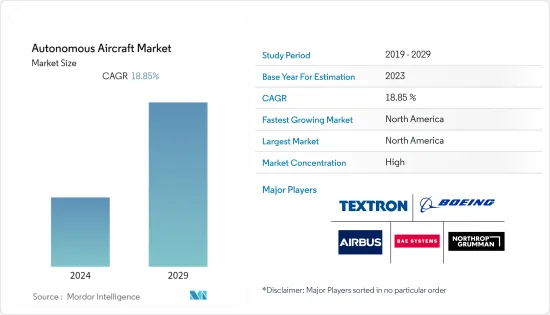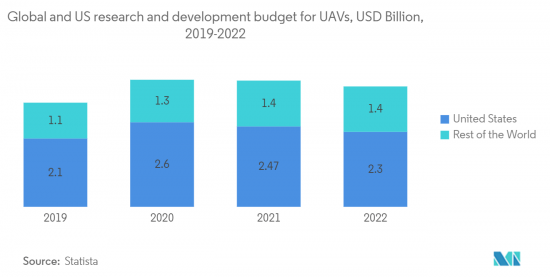PUBLISHER: Mordor Intelligence | PRODUCT CODE: 1404519

PUBLISHER: Mordor Intelligence | PRODUCT CODE: 1404519
Autonomous Aircraft - Market Share Analysis, Industry Trends & Statistics, Growth Forecasts 2024 - 2029

The autonomous aircraft market was valued at USD 10.47 billion in 2024 and is projected to reach USD 24.82 billion by 2029, registering a CAGR of 18.85% during the forecast period.
The market is driven by various factors, including the increasing need for efficient and safe transportation, advancements in artificial intelligence and sensor technologies, and the growing demand for unmanned aerial vehicles (UAVs) in military applications. The market also benefits from the rising investments by governments and private companies in research and development activities.
The regulatory challenges associated with the integration of autonomous aircraft into existing airspace systems hampers market growth. Additionally, the high cost of autonomous aircraft and the need for more skilled professionals in the field are some of the other restraints. In conclusion, the autonomous market has immense potential for growth in the forecasted period.
Autonomous Aircraft Market Trends
Autonomous Cargo Aircraft to Witness Rapid Market Share Growth During the Forecast Period
Cargo planes are expected to be the first to adopt this autonomous aircraft technology. In passenger flights, safety and the lives of people are given paramount importance, and thus, the adoption of autonomous aircraft should start after continuous and rigorous testing is done. This is not the case with cargo aircraft, as the level of life risk is zero with the use of autonomous aircraft in cargo planes. Additionally, the growth in the e-commerce industry is driving the air cargo demand, which may increase the demand for air cargo pilots in the near future.
Most of the developments in the autonomous aircraft market are aimed at bringing autonomous cargo aircraft into commercial use to fill in the gap due to the pilot shortage. For instance, in May 2023, Xwing was awarded a contract by the US Air Force to conduct pilotless cargo trials. As per the terms of the contract, Xwing will coordinate the identification of best use cases for autonomous flight operations with the Air Force and military stakeholders. Also, Xwing will conduct test flights that include a fusion of flight control systems, auto takeoff/landing, Detect-and-Avoid (DAA) systems, auto braking, auto taxi, and remote operations software to enable autonomous operations on the Cessna 208B platform. Many such developments are currently underway, and these are expected to help autonomous cargo aircraft be introduced into the market within the next decade.

North America is Expected to Continue its Market Share Dominance During the Forecast Period
North America currently has the highest market share in the autonomous aircraft market due to the high number of procurements of tactical autonomous UAVs in the region. Currently, the US is increasingly focused on the development of autonomous aircraft. Though the usage of autonomous aircraft has witnessed a slight setback due to the current regulatory framework in the commercial aviation sector, persistent R&D in the military sector for autonomous aircraft has been driving market growth. Technological advancement, which is high in countries like the US, has led to the development of advanced autonomous aircraft, which can adapt to changing conditions as well as handle flying situations without any human intervention. For instance, in December 2022, as a part of the Skyborg Program, the US DoD tested the autonomous F-16 jet VISTA X-62A for more than 17 hours of autonomous flight. In the test simulation, the VISTA jet operated by AI engaged in fighter maneuver skills and simulated dog fights, and AI outperformed the human pilot. The Skyborg Program was initiated in 2019 as part of a drive by the US Air Force goal to develop unmanned combat aerial vehicles. The US military also tested the first flight of a Black Hawk helicopter in November 2022. Lockheed Martin provided 'model following algorithm' (MFA) and a 'system for autonomous control of the simulation' (SACS) updates for the VISTA jet prior to testing in December 2021.
In the future, autonomous aircraft are also envisioned to be adopted on a wide scale for air cargo operations. This has encouraged several R&D projects to be initiated and has fostered the entry of new players in the autonomous aircraft ecosystem. For instance, in July 2023, Ribbit, a cargo airline startup developing software for autonomous flight, signed a USD 1.3 million contract with Transport Canada and Innovative Solutions Canada to begin testing self-flying aircraft in remote regions. The company has completed over 200 hours of hands-free flight on a two-seat airplane and is rapidly advancing operational testing in preparation for commercial service. The company will likely provide Transport Canada with a single aircraft along with remote crew and maintenance services to sustain autonomous cargo flights for one year. Transport Canada will also leverage this data to help inform future aviation regulations, standards, and policies.
Autonomous Aircraft Industry Overview
The autonomous aircraft market is still incubating and hence is consolidated in nature as a handful of players such as The Boeing Company, Airbus SE, Northrop Grumman Corporation, Textron Inc. (Bell Helicopters), and BAE Systems plc dominate market share, especially in the defense sector. However, most of the technologies being tested in the autonomous aircraft market are already the design standards in the UAV industry. Hence, it still trails in the measure of innovative developments in passenger and cargo-carrying applications.
Nevertheless, there are certain inherent capabilities exclusive to autonomous aircraft when compared to UAVs, such as endurance. On this note, in September 2021, Northrop Grumman unveiled the design of a new autonomous aircraft named Model 437, with a 3,000-mile range. The company has partnered with Scaled Composites to design the aircraft as a potential force multiplier for the US Air Force. The relatively new concepts are opening many opportunities for players to venture into the market. For instance, in October 2021, Textron Aviation entered an exclusive partnership with Xwing to develop autonomous flight capability for its current and future aircraft. Textron Aviation and Xwing are currently developing remote piloting technology for Textron's Cessna Grand Caravan utility aircraft. Similarly, in the US, the DARPA's ANCILLARY program aims to develop and flight demonstrate a small unmanned air system (UAS) with the critical technologies required for long endurance, vertical takeoff, and landing (VTOL) performance.
Additional Benefits:
- The market estimate (ME) sheet in Excel format
- 3 months of analyst support
TABLE OF CONTENTS
1 INTRODUCTION
- 1.1 Study Assumptions
- 1.2 Scope of the Study
2 RESEARCH METHODOLOGY
3 EXECUTIVE SUMMARY
4 MARKET DYNAMICS
- 4.1 Market Overview
- 4.2 Market Drivers
- 4.3 Market Restraints
- 4.4 Porter's Five Forces Analysis
- 4.4.1 Bargaining Power of Suppliers
- 4.4.2 Bargaining Power of Buyers/Consumers
- 4.4.3 Threat of New Entrants
- 4.4.4 Threat of Substitute Products
- 4.4.5 Intensity of Competitive Rivalry
5 MARKET SEGMENTATION
- 5.1 Aircraft Type
- 5.1.1 Fixed-wing
- 5.1.2 Rotary-wing
- 5.2 Application
- 5.2.1 Cargo Aircraft
- 5.2.2 Passenger Aircraft
- 5.3 End-user
- 5.3.1 Commercial
- 5.3.2 Defense
- 5.4 Geography
- 5.4.1 North America
- 5.4.1.1 United States
- 5.4.1.2 Canada
- 5.4.2 Europe
- 5.4.2.1 United Kingdom
- 5.4.2.2 France
- 5.4.2.3 Germany
- 5.4.2.4 Italy
- 5.4.2.5 Russia
- 5.4.2.6 Rest of Europe
- 5.4.3 Asia-Pacific
- 5.4.3.1 China
- 5.4.3.2 India
- 5.4.3.3 Japan
- 5.4.3.4 South Korea
- 5.4.3.5 Rest of Asia-Pacific
- 5.4.4 Latin America
- 5.4.4.1 Brazil
- 5.4.4.2 Mexico
- 5.4.4.3 Rest of Latin America
- 5.4.5 Middle East and Africa
- 5.4.5.1 Saudi Arabia
- 5.4.5.2 United Arab Emirates
- 5.4.5.3 Turkey
- 5.4.5.4 South Africa
- 5.4.5.5 Rest of Middle East and Africa
- 5.4.1 North America
6 COMPETITIVE LANDSCAPE
- 6.1 Vendor Market Share
- 6.2 Company Profiles
- 6.2.1 Northrop Grumman Corporation
- 6.2.2 The Boeing Company
- 6.2.3 Lockheed Martin Corporation
- 6.2.4 RTX Corporation
- 6.2.5 Elbit Systems Ltd.
- 6.2.6 AeroVironment, Inc.
- 6.2.7 Saab AB
- 6.2.8 BAE Systems plc
- 6.2.9 Airbus SE
- 6.2.10 Textron Inc.
- 6.2.11 IAI
7 MARKET OPPORTUNITIES AND FUTURE TRENDS




